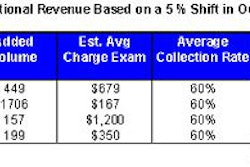Funding a PACS project in an institutional setting can be a Byzantine process, with more twists, turns, and dead-ends than this year's threatened major-league baseball strike. Healthcare institutions are often represented by multiple committees wielding separate agendas -- all of which must be appeased before a proposal can gain final approval. So while direct economic data will nearly always bolster the financial case for PACS, a good supply of intangible and anecdotal information may also be needed to tip the scales in favor of installation.
"Clearly, costs and savings generated are important, but fuzzy-economic and noneconomic advantages must be included to complement the hard facts," said Dr. James Ellis.
A professor of radiology at the University of Michigan Health System in Ann Arbor, MI, Ellis outlined strategies and tactics for PACS approval at the 2002 Symposium for Computer Applications in Radiology in Cleveland.
The warmup
Although there are direct savings to be gained from a PACS installation, such as lowered costs for film and processing supplies, these may not be enough to pay for the PACS investment considering all of the costs associated with equipment, service contracts, and maintenance. A PACS can be a significant capital cost, with recurring charges in hardware and software upgrades, as well as in skilled personnel to maintain the system.
"Specific cost savings should not be ignored," said Ellis. "Commodity costs are significant, including film, processors, and film storage. In addition, the cost of shipping images to various locations may be saved with a PACS installation."
There are also savings in personnel expense and throughput that can be attributed to a PACS. In an era of radiologist and technologist shortages, a system that will allow for fewer personnel to handle current procedure volume, or that can accommodate growth with the current staffing level, is a persuasive argument for the investment, noted Ellis.
The return on investment on the basis of these savings is generally calculated at approximately five years, depending on the exam volume of the institution. However, many of these models do not factor in service contracts or equipment upgrades. According to Ellis, recent U.S. studies have calculated the break-even point on a PACS investment at 40,000 to 50,000 annual exams by a facility.
The windup
Successfully navigating a PACS proposal through an institution requires a thorough understanding of the landscape. First and foremost is being aware of the limits of fundable projects available to the facility.
"There is little point in developing a project that will cost more than the institution can afford in capital expenditures, no matter how good the idea is," Ellis said.
The next step is to garner the support of key staff from a variety of departments. Ellis advocates identifying everyone who may be able to stop the project, and approaching these individuals for their input early in the process.
"Their potential objections should be sought, explored, and answered in the proposal, which may therefore undergo many revisions before it is formally submitted," he advised.
Finally, the CEO’s agenda and strategic vision be thoroughly understood before the proposal is crafted. PACS should be positioned to complement the assumptions and preconceptions of the CEO.
"For example, that PACS permits easy and low-cost growth is generally considered a plus, but could be a negative if the CEO does not foresee growth. Pushing the wrong positives may lead the CEO to conclude the investment is overpriced and would mean paying for unneeded capabilities to address nonexistent problems," noted Ellis.
The pitch
Economic intangibles put a spin on the PACS proposal that can ensure project delivery. Ellis advocates advancing a patient care argument as part of the justification for a PACS installation.
A PACS will improve communications between the radiology department and other clinicians both inside and outside the facility. Multiple concurrent access to images via dispersed workstations without having to physically locate film and assemble clinicians enables collaborative consultations as well as speedier diagnoses. In addition, digital image archives will diminish the significant time and frustration staff experience attempting to track down hard-copy images.
Patient service is also improved by the introduction of a PACS. The decentralization capabilities of electronic image systems can permit the reading of diagnostic images at a different location than where the exam was performed. This may enable patients to travel shorter distances for their procedures, as well as receive their results from the referring physician in a timelier manner.
Even the radiation dose may be reduced by the installation of a PACS. The wider latitude that digital modalities such as CR permit in exposure parameters can reduce the number of patient retakes. Moreover, PACS workstation software delivers many processing tools for manipulating images to the clinician that are simply not available with film, Ellis said.
"By the time the proposal reaches the desk of the CEO, you should already know it will be approved," he said.
Ellis suggests providing a list of peer, and slightly above peer, institutions that have successful PACS installations to the CEO as part of the proposal. As advertising professionals have known for years, perceived peer pressure is a powerful marketing tool. Although these arguments may not be persuasive on a conscious level, it can’t hurt to implant them in the subconscious, noted Ellis.
"Don’t be afraid to use the baser emotions. Envy and fear are perhaps the best. The CEO should fear that failure to implement PACS might leave the institution in the dust, as rival healthcare entities leapfrog past it in efficiency and worker satisfaction," he said. "And the CEO should be envious of other institutions that have already successfully implemented a PACS."
By Jonathan S. BatchelorAuntMinnie.com staff writer
July 26, 2002
Related Reading
The PACS soft sell, May 31, 2002
ARA adopts PACS for service, competitive reasons, April 26, 2002
Maximizing your investment in enterprise digital imaging, April 18, 2002
Negotiating PACS, from prenuptials to partnership, February 22, 2002
How to avoid PACS buyer’s remorse, September 27, 2001
Copyright © 2002 AuntMinnie.com


















